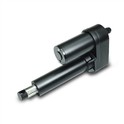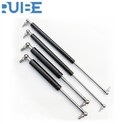Hey there! As a supplier of Cabinet Gas Dampers, I often get asked this question: "Can I adjust the damping force of a cabinet gas damper?" Well, let's dive right into it and find out.
First off, let's understand what a cabinet gas damper is. A Cabinet Gas Damper is a device that helps in the smooth opening and closing of cabinet doors. It uses gas pressure to control the movement, preventing the door from slamming shut or opening too quickly. This not only adds a touch of elegance to your cabinets but also extends the lifespan of the doors and hinges.
Now, back to the main question. The short answer is, it depends. Some cabinet gas dampers are designed to have adjustable damping force, while others are not.
Adjustable Damping Force Gas Dampers
There are certain models of cabinet gas dampers that come with an adjustable feature. These are great for those who want to customize the closing speed of their cabinet doors according to their preferences. For example, if you have a heavy cabinet door, you might want to increase the damping force to ensure a slow and smooth closing. On the other hand, if the door is light, you can reduce the damping force for a quicker yet still controlled closing.
The way these adjustable dampers work is usually through a small screw or valve on the damper itself. By turning this screw or adjusting the valve, you can either increase or decrease the flow of gas inside the damper. This, in turn, changes the damping force. It's a pretty simple process, but you do need to be careful not to over - adjust it. If you turn the screw too much, you might end up with a damper that doesn't work properly or even damage the unit.
Non - Adjustable Damping Force Gas Dampers
Not all cabinet gas dampers are adjustable. Many standard models are designed to have a fixed damping force. These are typically more affordable and are suitable for most general cabinet applications. The manufacturers have pre - set the damping force based on the average weight and size of cabinet doors. So, if you have a regular cabinet door that isn't too heavy or too light, a non - adjustable damper will do the job just fine.
The advantage of non - adjustable dampers is their simplicity. There's no need to worry about adjusting anything, and they are generally more reliable in the long run because there are fewer moving parts that can break. However, if you have specific requirements for the closing speed of your cabinet doors, a non - adjustable damper might not be the best choice.


Factors to Consider
When deciding whether to choose an adjustable or non - adjustable cabinet gas damper, there are a few factors you should take into account.
- Door Weight: As mentioned earlier, the weight of the cabinet door is a crucial factor. If the door is heavy, an adjustable damper might be necessary to ensure a smooth closing. A non - adjustable damper might not be able to handle the weight, and the door could slam shut.
- Usage Frequency: If the cabinet door is used frequently, you might want to consider an adjustable damper. Over time, the damping force of a non - adjustable damper might change slightly due to wear and tear. With an adjustable damper, you can easily make adjustments to maintain the desired closing speed.
- Budget: Adjustable dampers are usually more expensive than non - adjustable ones. If you're on a tight budget, a non - adjustable damper could be a more cost - effective option.
Applications in Different Settings
Cabinet gas dampers are used in a variety of settings, from residential kitchens to commercial storage units.
In a residential kitchen, adjustable dampers can be a great addition. You might have different types of cabinet doors in your kitchen, some with heavy glass fronts and others with lightweight wooden panels. With adjustable dampers, you can customize the closing speed for each door, ensuring a consistent and smooth operation.
In commercial settings, such as office storage cabinets or retail display cabinets, non - adjustable dampers are often preferred. These settings usually have a large number of cabinets, and it would be time - consuming to adjust each damper individually. Non - adjustable dampers provide a reliable and cost - effective solution for these large - scale applications.
Comparison with Other Types of Dampers
It's also worth comparing cabinet gas dampers with other types of dampers, such as hydraulic dampers. While hydraulic dampers are known for their high - precision damping, they are often more expensive and require more maintenance. Gas dampers, on the other hand, are relatively inexpensive and easy to install. They also work well in a wide range of temperatures, making them suitable for various environments.
Another type of damper is the mechanical damper. Mechanical dampers are simple and affordable but might not provide the same level of smoothness as gas dampers. Gas dampers use the compressibility of gas to create a more consistent and controlled damping force, which is especially important for cabinet doors.
Our Products as a Supplier
As a supplier of Cabinet Gas Dampers, we offer a wide range of products to meet different customer needs. We have both adjustable and non - adjustable dampers in various sizes and specifications. Our adjustable dampers are easy to adjust, even for those with little technical knowledge. We also ensure that all our dampers are made from high - quality materials to guarantee long - term performance.
If you're in the market for a Gas Damper for Car, we also have a selection of products suitable for automotive applications. Our car gas dampers are designed to provide smooth and reliable operation, ensuring the safety and comfort of your vehicle.
Conclusion
So, can you adjust the damping force of a cabinet gas damper? The answer is yes in some cases and no in others. It all depends on your specific needs, the weight of the cabinet door, and your budget. Whether you choose an adjustable or non - adjustable damper, make sure to select a high - quality product from a reliable supplier.
If you're interested in purchasing cabinet gas dampers or have any questions about our products, feel free to get in touch with us. We're here to help you find the perfect solution for your cabinet needs. Let's start a conversation and see how we can work together to make your cabinets function at their best!
References
- "Damping Technology Handbook" by John A. Schetz
- "Gas Spring Design and Application" by various industry experts






